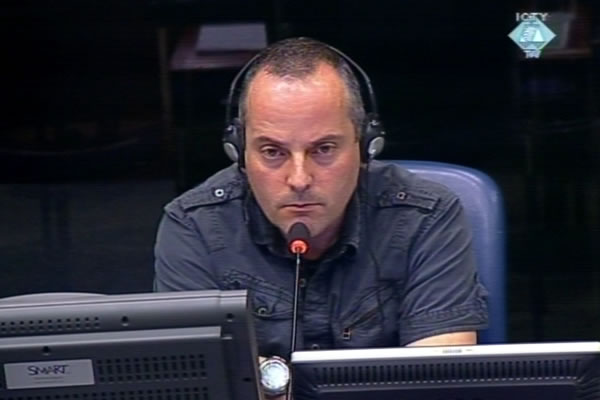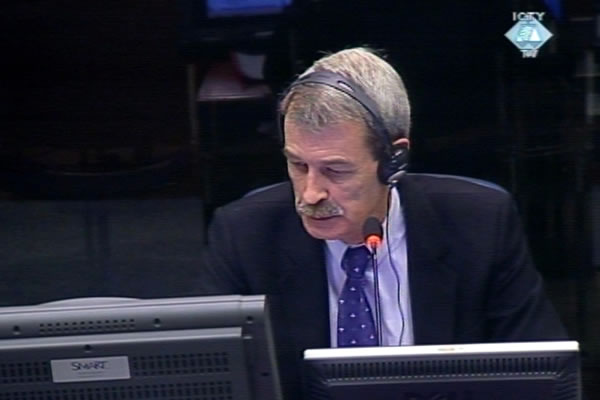Home
SREBRENICA WAS CAPTURED ‘RAMBO STYLE’
Former member of the UN Dutch Battalion in Srebrenica, Roger Patelski, described the Serb soldiers as ‘Rambo types’ who ‘carried out the mop-up operation’ alongside the road to the UN base in Potocari. Grenades went off and people screamed as they went from house to house. Former deputy commander of the Dutch Battalion Robert Franken testified about the ‘convoy terror campaign’. Karadzic has refuted their evidence, claiming that it was never the Serbs’ plan to enter Srebrenica. According to Karadzic, Serbs only entered the town because both the civilians and the soldiers had left
 Roger Patelski, witness at the Radovan Karadzic trial
Roger Patelski, witness at the Radovan Karadzic trial Former member of the Dutch Battalion Roger Patelski described at the trial of Radovan Karadzic how he watched the Serb forces enter Potocari on 12 July 1995 from his observation post about one kilometer north of Srebrenica. About a hundred Serb soldiers disarmed the witness and other Dutch soldiers at the observation post. When fresh Serb troops arrived, the ‘mop-up’ operation began.
The Serb soldiers looked like ‘Rambo types’. They advanced towards the UN base in Potocari going from house to house, throwing grenades into them and then made the dogs enter the houses. ‘I saw fire and heard explosions and people screaming’, the witness said, adding that the ‘mop-up’ operation he followed from his observation post lasted several hours.
Karadzic tried to contest this part of the witness’s evidence in his cross-examination. He argued that the entire civilian population had already reached the base in Potocari and the soldiers were heading towards Tuzla. The Serb soldiers found weapons in haystacks next to the abandoned houses and this prompted them to torch the houses, Karadzic explained.
As the witness recounted, a while later he saw a freshly dug grave in the UN base in Potocari. The grave was about two meters wide. When Karadzic put it to the witness that the grave hadn’t been found yet because it actually never existed, the witness replied that as the grave was being filled, he saw an arm sticking out from the ground.
After Roger Patelski completed his evidence, retired lieutenant colonel Robert Franken was called to the witness stand. At the time of the fall of the Srebrenica enclave, Franken served as the deputy commander of the UN Dutch Battalion. Franken has already given evidence at five trials in The Hague. At Karadzic’s trial, Franken’s written statement summarizing his testimony at the Blagojevic, Popovic and Tolimir trial, was admitted into evidence.
In his testimony at other trials, Franken spoke in detail about the restrictions the VRS imposed on the convoys moving into the UN-protected enclaves; he called it the ‘convoy terror campaign’. Franken also spoke about the VRS ‘test attack’ on the Echo Observation Post on 3 June 1995, the heavy shelling of Srebrenica and the arrival of the Serb forces in the protected area. The Echo Observation Post was attacked to see how the UN peace keepers would respond.
In the cross-examination, Karadzic noted that the Main Staff didn’t restrict the movement of convoys out of any malicious intent, but because it had received reports that convoys were used to smuggle arms. ‘I am pretty sure that the convoys supplying the Dutch battalion in Srebrenica were not used for any untoward purpose’, Franken replied. He dismissed Karadzic’s claims that the objective of the VRS operations in June and July 1995 were not to enter Srebrenica. The only reason the VRS eventually entered the town was because the ‘28th division withdrew and the town was left empty’, Karadzic put it to the witness.
Karadzic will complete his cross-examination of Robert Franken tomorrow morning.
Photos
Linked Reports
- Case : Karadzic
- 2012-01-13 KARADZIC 'WATCHED PANDUREVIC'S BACK'
- 2012-01-12 WITNESS: SERB OFFICERS TOLD US THEY WANTED SREBRENICA FOR THEMSELVES
- 2012-01-11 KARADZIC DENIES MASS EXECUTIONS
- 2012-01-17 KARADZIC: ‘SERBS PROVED THEIR NOBILITY’ IN SREBRENICA
- 2012-01-18 WHO’S RESPONSIBLE FOR THE BAD IMAGE OF KARADZIC’S TROOPS IN WESTERN MEDIA?
- 2012-01-20 KARADZIC’S MOTION TO RECALL 12 ‘MUNICIPALITY WITNESSES’ REJECTED

